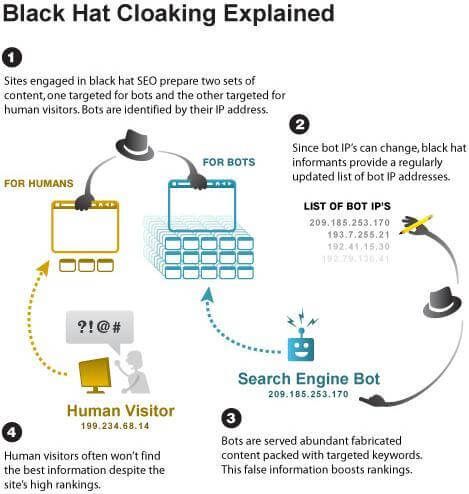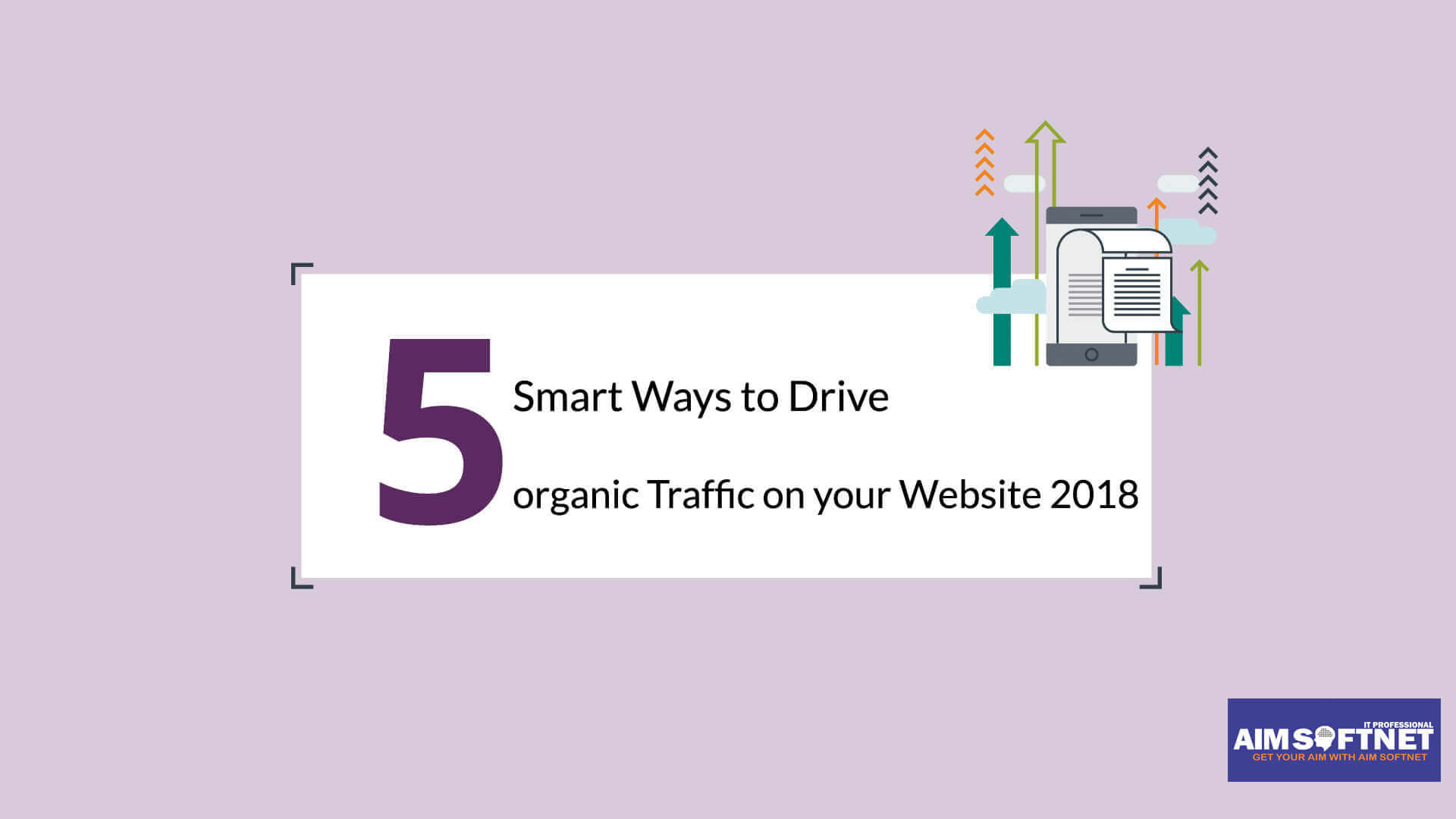Black Hat SEO Techniques 2019 SEO is an important part of every business. But despite that, it is the most misinterpreted terms in the world of Marketing. Since SEO plays a vital role in the online presence of your business, most people do all sort of illegal activities to gain the results in a shorter span of time. In this article, we will read about Black Hat SEO Techniques that you should avoid at any cost otherwise it will affect your website very badly sooner or later.Contrary to Black Hat SEO techniques, we have White Hat SEO techniques (SEO techniques that adhere to search engines guidelines) which include On Page SEO Strategies and Off Page SEO strategies etc.
What is Black Hat SEO?
 Before jumping to Black Hat SEO techniques directly, let’s see what exact Black hat SEO definition is. In simple terms, Black Hat SEO is a practice that involves improving the ranking of your website or pages by means that violate Google’s (or any other search engines) TOS (terms of service). Black Hat SEO Techniques 2019 Its main job is to impress search engine bots (or spiders) to rank higher in SERPs and does not think about users. There are many things that can happen such that it may not always provide the relevant content to the readers or you are violating the SEO guidelines set by the different search engines. Black hat strategies have a negative reputation and which is right too. If you are providing relevant & quality content to the users then there is no need to cheat and do any inappropriate tasks. Black hat SEO techniques can be successful in the short term, but they have serious consequences in the long run and it may even force Google to penalize your blog.
Before jumping to Black Hat SEO techniques directly, let’s see what exact Black hat SEO definition is. In simple terms, Black Hat SEO is a practice that involves improving the ranking of your website or pages by means that violate Google’s (or any other search engines) TOS (terms of service). Black Hat SEO Techniques 2019 Its main job is to impress search engine bots (or spiders) to rank higher in SERPs and does not think about users. There are many things that can happen such that it may not always provide the relevant content to the readers or you are violating the SEO guidelines set by the different search engines. Black hat strategies have a negative reputation and which is right too. If you are providing relevant & quality content to the users then there is no need to cheat and do any inappropriate tasks. Black hat SEO techniques can be successful in the short term, but they have serious consequences in the long run and it may even force Google to penalize your blog.
Black Hat SEO Techniques You Should Avoid
Below are the various tactics that can help you to cheat search engines and rank higher but should not be practiced. If you are considering hiring SEO specialists, you should check that they are not using any of the following black hat SEO practices :
- Cloaking
Top of our Black Hat SEO techniques is Cloaking. It is a practice carried out to cheat and fool search engines by showing different content to the search engines bots and different content to the users. This SEO method is considered deceptive because it tricks search engines in order to get the desired ranks for target keywords. As per the Google. Cloaking is defined as:
- Serving a page of HTML text to search engines while showing a page of images or Flash to users.
- Inserting text or keywords into a page only when the user agent requesting the page is a search engine, not a human visitor.
Search engines especially Google uses its search algorithms to locate such activities, and if detected, such websites are subjected to a penalty which can lead to the complete ban or de-indexing of your website.

2) Keyword Stuffing
Keyword stuffing is an old technique which helped webmaster to rank higher in the search engines. They just used to stuff the keywords they are targeting for any particular topic and rank high. But it was very annoying. When the keyword is stuffed without any actual need, readers may become irritated and confused and some will even leave your website page. But now, Search engines algorithms have become more efficient and they notice if the keyword is overly optimized and can lead to site’s penalty. Search engine crawlers are more interested in your site’s content.
As per Google,
Examples of keyword stuffing include:
- Lists of phone numbers without substantial added value
- Blocks of text listing cities and states a webpage is trying to rank for
- Repeating the same words or phrases so often that it sounds unnatural, for example:
We sell custom cigar humidors. Our custom cigar humidors are handmade. If you’re thinking of buying a custom cigar humidor, please contact our custom cigar humidor specialists at custom.cigar.humidors@example.com.

3) Doorway Pages or Gateway Pages
Whenever we talk about Black Hat SEO techniques and leave this strategy, it will be very unfair. Let’s read what exactly this SEO method is. Doorway pages or Gateway pages are keyword-rich, content-poor pages designed to fool search engines. These types of pages contain tons of keywords, but no real information. They majorly focus on calls-to-action and links that send the users through to a landing page. It is an adapted way of redirecting.
They are designed for search engines and not for the end user. The end user never sees these pages because they are automatically redirected to the target page.
4) Hidden Text and Links
Invisible/Hidden text or links is any text that search engines bots can read but normal users can’t. The Hidden text implies that color of your text is same as the color of your background. For example, you are having white text on the white background. This approach many people use to stuff extra links or keywords to boost page’s ranking. In this way, users won’t be able to find this hidden text but search engines can read this.
Another approach (apart from tiny text or same color text) for hidden content that many webmasters use is comment tags. The comment tags (<!– Comment Tag –>) are meant for the developer to add in useful reminders within their code explaining what that piece of code does.
Along with time, search engines algorithms have changed a lot and now search engines bots have an automated system that goes through your source code to trace even the slightest of error. So, before Google or any other search engine finds it out and you get penalized for it, it is better to make sure that your source code and logs are ‘hidden content -free’.
5) Duplicate Content / Content Theft
As the name suggests, duplicate content or content theft refers to the stealing content from other websites and having duplicate content on your blog. This is most commonly known as plagiarism. There are many anti-plagiarism applications available on the internet which can quickly detect duplicate content. Search engines prefer unique content to provide to the users which is why duplicate content across different website/domains is perceived as one of the worst black hat SEO techniques. Search engines do not index the ‘original’ content more than once. In fact, all such copied content goes to waste. This duplicate content concerns not only different domains but also can occur on one domain itself. If you are having duplicate content on your site, either remove it or use proper URL Canonicalization
6) Article Spinning
Article Spinning is an act of crafting a way of rewriting content just to avoid the duplicate content issue. Its aim is to generate/show new content to impress search engines. We all know that keeping our site updated on a regular basis is very important and also a good SEO practice. This article spinning is a technique to escape from producing fresh content. It uses software (many articles spinning articles available on the internet) to take a single article and rewrite it into several different new articles. The new articles are often terribly written and don’t provide any new information to readers. It is considered as one of black hat SEO techniques because you provide fresh relevant information for the user. If you discovered something new about a topic you already covered in an article, you could just write the new piece of information as an update rather than writing a new article altogether by spinning it.
7) Bait-and-Switch or Page Swapping
This SEO technique includes changing a page which is already indexed, ranked and popular with traffic and making it completely different from the previous version. Many webmasters use this Bait-and-switch or Page swapping to first ranks a site by a niche and then changes the entire niche of the site with different contents. So the visitors while searching by keywords will eventually land on a page where nothing will be their similar to their search. This strategy happens when you convert your content into a commercial one. But keep in mind that search engines don’t like visitors to be cheated. If any search engine finds that you are doing page swapping then your site will definitely be penalized. Do not use such type of wrong methods, keep it organic.
8) Cookie Stuffing or Cookie Dropping
Cookie stuffing or cooking dropping is one of the worst Black Hat SEO Techniques. It is an illegal practice which includes putting a cookie on someone’s computer without them knowing. When a visitor visits a website, the visitor’s browser is poured by third party cookies which are from an entirely different website. Some people use it on their review sites so they still can get a commission even if the person doesn’t click through their link. In other words, they are making money not by referring people to the merchant’s website as they should be doing, but by secretly loading the website (and dropping the affiliate cookie) in the background without the visitor’s knowledge. When the visitors visit the website for which the cookies had been placed and if they convert (any items purchased, any lead is generated), the cookie stuffer gets paid.

9) Link Buying or Exchange
Search engines consider backlinks and inbound links as a ranking factor to rank your page. It is right too because more the people link to your page, the more relevant your content presumably is. But nowadays, people have started buying links or doing link exchanges to get a huge number of links and forget that it must be natural. This technique used to be effective in the old days, until Google devised algorithms to discourage such activity. If the source of the links is irrelevant to your site, it can have a negative impact on your site’s SEO. There are many sites and directories available that offer links exchange or keyword targeted links, quality links for your niche etc. It is easy to get such links but sooner or later you will get your site penalized easily. Similarly, reciprocal links and link farming (or link farms) are also not appreciated by Google and other search engines. So, don’t ever try that out that method to get the backlink!
10) Private Blog Networks (PBN)
Private Blog Networks (PBN) is nothing but a collection of blogs created by a person to generate links to a site and to help it rank in search engines. It is considered as a black hat strategy. Usually, PBNs are created using expired domains. This is because expired domains already have link juice and that can come in handy when you are trying to pass authority to another site that doesn’t have so much. It is a powerful way of creating a massive number of links from different domains to a site. The deceptive part of it is you have control over the network. No matter how regardless horrible or low quality your content is, you can link it up with catchy anchor text leading to good ranking quickly. The owner of the network can change the content however he wants, to add how many links he wants and to manipulate the content to his own wishes to boost the rank for a site. It was a tricky way till now to rank higher but Google is now all set to target PBNs and whosoever is found guilty will have to face penalties and can even lead to complete site banned.
11) Clickbait
Clickbait is one of the most used Black Hat SEO techniques being used these days. As per Wikipedia, Clickbait is a pejorative term for web content whose main goal is to get users to click on a link to go to a certain webpage, this is especially done at the expense of quality or accuracy, relying on sensationalist headlines or eye-catching thumbnail pictures to attract click-throughs and to encourage forwarding of the material over online social networks. Clickbait headlines typically aim to exploit the “curiosity gap”, providing just enough information to make readers curious, but not enough to satisfy their curiosity without clicking through to the linked content.
In simple words, Clickbait is an eye-catching and deceptive headline written with the sole purpose of making you click on it. It says one thing in the headline and another thing on the site. It uses various expressions, emotions to entice users to click on the article links. Nowadays, all the social platforms primarily Facebook and Instagram are flooded with clickbait headlines to provoke users to click on their posted articles. Clickbaiting can increase rankings and click-baiting can provide you better CTR (i.e. more views). But in reality, clickbaiting can actually do more harm than good to your SEO.
12) Cybersquatting or Domain Squatting
Squatting, in general terms, is the action of occupying an abandoned or unoccupied area of land or a building, usually residential, that the squatter does not own, rent or otherwise have lawful permission to use. Here, Cybersquatting or Domain squatting means registering domains similar to a trademark or business for the sole purpose of getting financial benefits. Fraudsters who practice this technique could receive lawsuits because they gain money. They are redirecting people who came on the fake domain to an expensive pay-per-click advertising site. Here search engines do not play a decisive role here. The main authority to deal with such type of issues is the ICANN (Internet Corporation for Assigned Names and Numbers).
Another such term is Typosquatting or URL Hijacking. This hijacking method is based on a typographical error to create malicious domains to look similar to well-known brands. This error counts as a common misspelling, unnoticed foreign spelling, an abuse of the Country Code Top-Level Domain. The reason for this “affiliating” practice is to profit from the trademark name and brand’s fame. For example: if you buy a domain “Facebooq” that’s a kind of a Typosquatting. Google does not have any strict law for this but you can always take precautions and be on safer side.
13) Google Bombing
Google bombing is a practice some carried out by some SEO specialists to reduce their competitor’s rankings. It refers to the set of tactics for manipulating the search results of competitors. These can include creating negative pages about competitors or media campaigns to generate user-created web pages to redefine or recontextualize a particular keyword and media campaigns to boost the popularity of trending terms and phrases usually negative ones. Though it can be effective but search engine often quickly limit their effectiveness once discovered.
14) Mirror Sites
Mirror sites are used to reflect the original website content into a new one in order to increase its ranking. This could be another way of duplicating content from your site or other resources. To cover this act of using black hat SEO techniques, they try and convince you that they are using this technique just in case of DDoS (Distributed Denial of Service) attacks. DDoS is a cyber attack in which multiple compromised computer systems attack a target, such as a server, website or another network resource, and cause a denial of service for users of the targeted resource. The flood of incoming messages, connection requests or malformed packets to the target system forces it to slow down or even crash and shut down, thereby denying service to legitimate users or systems.
15) Parasite Hosting
Parasite hosting involves hosting a website on another individual’s computer or server for SEO purposes. It is an illegal way of gaining access to a site, creating a web page on it and inject it with lots of keywords and links pointing to the commercial page. They set up a parasite hosting to take advantage of the authoritative domains from Google. This way they would receive traffic for their site and money from those who want to buy. Since the hijacked website shows no symptoms or signs that it is breached, it may become very difficult to detect without vigilant and consistent security measures. If you get caught, you will have to face a terrible penalty.
Other Black Hat SEO Techniques To Avoid
Apart from above-mentioned strategies, there are few other black hat SEO techniques that you have to avoid in order to protect your site from being penalized. They are as following:
- Meta Tag/Description Stuffing: This is the practice of filling meta tags and meta descriptions with keywords and phrases to convince search engine crawlers to index and rank web pages high for those keywords and phrases. This may cause a negative impact on your site’s SEO.
- Scraper sites: Scraper sites refer to websites created by programs that “scrape” other sites for unique content and amalgamate it. These sites are often filled with ads, and/or used to promote a practitioner main site.
- Referrer Spam: Referrer spamming is a sort of spamdexing which is manifested by polluting a site with fake statistical data. The spammer aims to improve the ranking of his/her site by using a fake referrer URL redirecting towards a site for which a spammer will bombard repeated requests to you.
- Pingback Spam: Some practitioners set up scripts to notify search engines of content repeatedly to create the illusion that it is new.
- Automated Google Queries: Sending automated Google queries means that you use a software to inflate the number of searches for a specific keyword to rank higher in SERP. If you indulge in this, Google & other search engines can ban your site.
- Rich Snippet Markup Spam: Structured markup data can be a great way of formatting how your site appears in the search But if you are creating irrelevant rich snippets markup you risk getting manually penalized by Google for this spammy technique.
- Over-Optimized Alt Description & HTML Heading Over-Optimizing: It includes practicing keyword stuffing in your ALT description of the image and using multiple H1s on a page etc.
- Directory Listing: Registering and/or buying placements on low-quality directories, it is not good practice
Conclusion
To sum everything up, while doing SEO for blogs, these black hat SEO techniques can give you some instant results but you cannot get away after practicing these. The short-term gain is not worth the long-term consequences. Once search engines find your website violating the rules, you will start losing rank or traffic, damaging your reputation and above all get a penalty from search engines sooner or later. You can also face a complete site ban or worst of all – face a lawsuit. I would recommend you keeping everything natural and following White Hat techniques and consider providing the good user experience. It may take some time to see the results but it will definitely help you in the long run.
In the last, what other Black Hat SEO techniques you recommend others to avoid? Also, Don’t Forget To Share It with your friends and subscribe to our Email newsletter for more such updates. If you have any questions, please feel free to ask in the comments section below.





